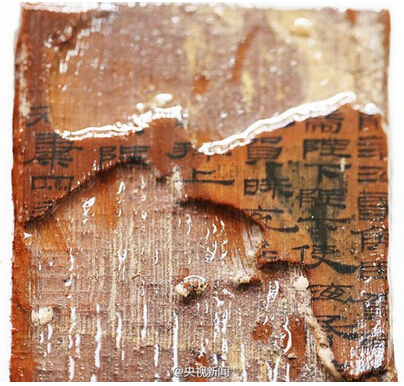Information
Handwritings and symbols found at Emperor Liu He's tomb
Summary: The site of Western Han Dynasty (206 BC-AD 24) Emperor Liu He's tomb recently offered new findings as the archaeological work has entered the stage of dismantling the outer coffin. Archaeologists have found numerous handwritings and symbols at the bottom
The site of Western Han Dynasty (206 BC-AD 24) Emperor Liu He's tomb recently offered new findings as the archaeological work has entered the stage of dismantling the outer coffin. Archaeologists have found numerous handwritings and symbols at the bottom of the outer coffin, according to Nanchang Evening News.
Liu He (92-59 BC), who was later given the title "Haihunhou" (the Marquis of Haihun), was the grandson of Emperor Wu, the greatest ruler of the Han Dynasty (206 BC-AD 220), one of the most prosperous periods in Chinese history.

File photo of artifacts unearthed from the Haihunhou cemetery in Nanchang, East China's Jiangxi Province.(Photo/CCTV Weibo)
Handwritings and symbols seen at the coffin bottom
The main coffin chamber of Liu He's tomb has been dismantled since September, and now the third level of the tomb is under extraction and dismantling. Crosstie and charcoal will be extracted later, which may reveal remains of sacrifices or other relics.
Archaeological expert Yang Jun said that they found handwritings and some symbols on the coffin and their meanings are still unknown, but archaeologists guess it marks the information of the coffin, such as the size and origin. Yang revealed that the dismantling work will last for two months. Archaeologists will number each piece of coffin wood, which will be recorded, photographed and scanned before dismantling. After that, experts will excavate or dissect the tomb bottom for two months. The dismantled coffin wood will be dehydrated, undergo insect and pollution proofing and restored to the original position after the excavation work.
Ancient bamboo book discovered in the tomb
According to a previous report from the magazine Archaeology, the bamboo book unearthed from the Haihunhou tomb titled Wu Se Shi Sheng (Five-colored Food Treasure) is a book about the art of necromancy with five colors representing five kinds of food, resembling the Chinese wuxing (five phases of wood, fire, earth, metal and water) theory.
However, according to experts from Fudan University, "green" and "white" are only words about colors discovered in the book, which refer to black and white. As there was a chessboard found in the tomb before, experts guess the book is about Liubo, a popular chess game from the Han Dynasty (206 BC-AD 220). After comparing with other chess-related books, the experts are more certain about the conclusion, who said that the Wu Se Shi Sheng should change its name to Liubo Chess Manual, which will be the first discovered book about Liubo chess.
As the archeological work of Liu He's tomb comes to an end, the Number 2 tomb that belongs to Liu He's wife will undergo excavation soon after the approval of the State Administration of Cultural Heritage.
Liu He (92-59 BC), who was later given the title "Haihunhou" (the Marquis of Haihun), was the grandson of Emperor Wu, the greatest ruler of the Han Dynasty (206 BC-AD 220), one of the most prosperous periods in Chinese history.

File photo of artifacts unearthed from the Haihunhou cemetery in Nanchang, East China's Jiangxi Province.(Photo/CCTV Weibo)
Handwritings and symbols seen at the coffin bottom
The main coffin chamber of Liu He's tomb has been dismantled since September, and now the third level of the tomb is under extraction and dismantling. Crosstie and charcoal will be extracted later, which may reveal remains of sacrifices or other relics.
Archaeological expert Yang Jun said that they found handwritings and some symbols on the coffin and their meanings are still unknown, but archaeologists guess it marks the information of the coffin, such as the size and origin. Yang revealed that the dismantling work will last for two months. Archaeologists will number each piece of coffin wood, which will be recorded, photographed and scanned before dismantling. After that, experts will excavate or dissect the tomb bottom for two months. The dismantled coffin wood will be dehydrated, undergo insect and pollution proofing and restored to the original position after the excavation work.
Ancient bamboo book discovered in the tomb
According to a previous report from the magazine Archaeology, the bamboo book unearthed from the Haihunhou tomb titled Wu Se Shi Sheng (Five-colored Food Treasure) is a book about the art of necromancy with five colors representing five kinds of food, resembling the Chinese wuxing (five phases of wood, fire, earth, metal and water) theory.
However, according to experts from Fudan University, "green" and "white" are only words about colors discovered in the book, which refer to black and white. As there was a chessboard found in the tomb before, experts guess the book is about Liubo, a popular chess game from the Han Dynasty (206 BC-AD 220). After comparing with other chess-related books, the experts are more certain about the conclusion, who said that the Wu Se Shi Sheng should change its name to Liubo Chess Manual, which will be the first discovered book about Liubo chess.
As the archeological work of Liu He's tomb comes to an end, the Number 2 tomb that belongs to Liu He's wife will undergo excavation soon after the approval of the State Administration of Cultural Heritage.
Category: English
News
Information
Key words:
